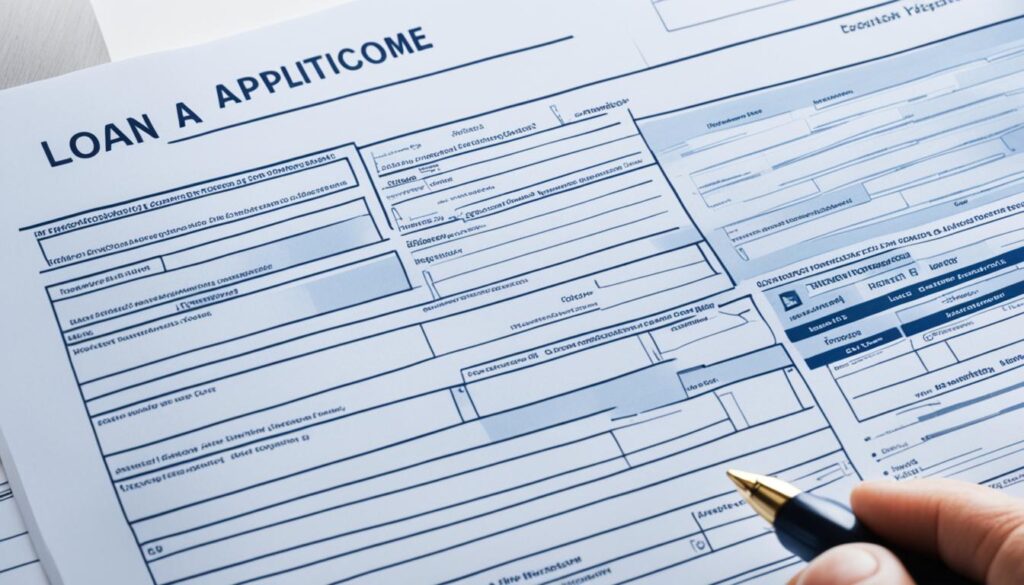Are you tired of feeling limited by your income? Do you have dreams and goals that seem out of reach due to financial constraints? Fortunately, there is a solution that can help you bridge the gap and turn your dreams into reality – low income personal loans.
Low income personal loans are specifically designed to assist individuals with limited income in achieving their financial aspirations. These loans are accessible and tailored to your unique circumstances, allowing you to borrow the funds you need to pursue your goals.
Whether you’re looking to start a small business, pursue further education, or consolidate debt, low income personal loans can provide the financial boost you need. These loans take into account your income level and offer flexible repayment options that align with your budget.
Key Takeaways:
- Low income personal loans can help individuals with limited income achieve their financial goals.
- These loans are accessible and tailored to accommodate your unique circumstances.
- You can use low income personal loans to start a business, pursue education, or consolidate debt.
- Repayment options for low income personal loans are flexible and can be customized to fit your budget.
- Consider low income personal loans as a way to bridge the gap between your dreams and reality.
Understanding Low Income Personal Loans
Low-income individuals often face financial challenges when it comes to achieving their goals or managing unexpected expenses. Traditional loans may not be easily accessible or tailored to their specific needs. That’s where low income personal loans come in.
What exactly are low income personal loans? These loans are specifically designed to provide financial assistance to individuals with limited income. They are offered by lenders who understand the unique circumstances faced by low-income borrowers and aim to bridge the gap by providing suitable loan options.
The main difference between low income personal loans and traditional personal loans lies in their eligibility requirements and terms. While traditional personal loans typically consider credit scores and income, low income personal loans prioritize income as the primary factor. Lenders take into account an individual’s income level and stability to determine the loan amount that they can comfortably repay.
When searching for low income personal loans, it’s crucial to choose the right lender. Look for lenders who specialize in serving low-income individuals and have a track record of providing fair and transparent loan terms. Conduct thorough research and compare different lenders to ensure you make an informed decision that aligns with your needs and financial situation.
Remember, low income personal loans are designed to assist individuals in achieving their financial goals, so it’s important to work with a reputable lender who understands your unique circumstances.
By focusing on income rather than credit score, low income personal loans provide an opportunity for individuals with low income to access the financial support they need. Whether you’re looking to consolidate debt, cover medical expenses, or pursue educational opportunities, these loans can offer the flexibility and affordability you require.
How do low income personal loans work?
Low income personal loans typically involve the following steps:
- Application: Start by filling out an application with a lender who offers low income personal loans. Be prepared to provide information about your income, expenses, and any outstanding debts.
- Income verification: Lenders will require proof of your income, such as pay stubs, tax returns, or bank statements. This helps them assess your repayment capacity and determine the loan amount you qualify for.
- Loan amount and terms: Based on your income and financial situation, the lender will determine the maximum loan amount you can borrow and offer suitable repayment terms, including interest rates and loan duration.
- Approval and disbursement: If your loan application is approved, the lender will disburse the funds to your designated bank account. From there, you can use the loan amount as needed.
- Repayment: Repay the loan according to the agreed-upon terms. Timely repayment can help build your credit history and improve your financial standing for future borrowing needs.
Low income personal loans provide a valuable resource for individuals who need financial assistance but have limited income. By focusing on income as the determining factor, these loans prioritize affordability and empower low-income borrowers to achieve their financial goals.
Qualifying for a Low Income Personal Loan

When it comes to qualifying for a low income personal loan, there are several factors that lenders take into consideration. These factors help lenders assess your eligibility and determine the loan terms that best suit your financial situation. In this section, we’ll explore the key aspects that lenders look at, including credit score, income requirements, and proof of income.
Evaluating Credit Score
Your credit score plays a crucial role in the loan approval process. Lenders use it to assess your creditworthiness and evaluate the risk associated with lending to you. While a high credit score is preferable, having a bad credit history doesn’t necessarily prevent you from getting a low income personal loan. Some lenders specialize in offering loans to individuals with less-than-perfect credit. However, keep in mind that a higher credit score can increase your chances of securing a loan with more favorable terms.
Meeting Income Requirements
Lenders typically set income requirements to ensure that borrowers have the financial means to repay the loan. While low income personal loans are specifically tailored for individuals with limited income, you’ll still need to meet certain income criteria. These requirements vary among lenders, so it’s essential to research and find a lender that aligns with your income level. For instance, credit unions often have flexible income requirements and may be more willing to work with low-income borrowers.
Providing Proof of Income
As part of the loan application process, you’ll be required to provide proof of income to verify your ability to repay the loan. This documentation typically includes recent pay stubs, bank statements, or tax returns. Lenders use this information to assess your income stability and determine if you qualify for the loan. It’s crucial to have these documents prepared and readily available to expedite the application process and increase your chances of approval.
“Having a low income doesn’t automatically disqualify you from obtaining a personal loan. Lenders take various factors into account, including credit score, income requirements, and proof of income. By understanding these criteria and working with the right lender, you can secure a low income personal loan that suits your financial needs.”
Additionally, credit unions are worth considering as alternative lenders for low-income individuals. These member-owned financial institutions often prioritize community support and may have more lenient eligibility criteria compared to traditional banks. They can provide personalized loan options and financial guidance tailored to your specific circumstances.
Overall, qualifying for a low income personal loan requires attention to your credit score, meeting income requirements, and providing proof of income. By understanding these factors and exploring different lender options, you can increase your chances of securing a loan that helps you navigate your financial goals.
Secured vs. Unsecured Low Income Personal Loans

When considering a low income personal loan, it’s essential to understand the key differences between secured and unsecured loans. Both options can provide financial assistance to individuals with limited income, but they operate in distinct ways and carry different benefits and considerations.
Secured Loans
A secured loan requires borrowers to provide collateral as a form of security for the lender. This collateral can be an asset such as a car, home, or another valuable possession. By securing the loan, borrowers reduce the risk for the lender, enabling them to offer more favorable terms and lower interest rates.
Secured loans are generally accessible to individuals with low income as the collateral helps mitigate the lender’s risk. The loan amount is typically based on the value of the collateral, and borrowers may be able to secure larger loan amounts compared to unsecured loans.
One of the main advantages of a secured loan is the potential for lower interest rates. Lenders are more willing to offer competitive rates because they have the collateral as security. This can result in significant savings over the life of the loan.
“Secured loans provide an excellent option for low-income individuals who have valuable assets that can serve as collateral. These loans offer lower interest rates and larger loan amounts, making them suitable for longer-term financial goals.”
Unsecured Personal Loans
In contrast, unsecured personal loans do not require collateral. This type of loan is based primarily on the borrower’s creditworthiness, income, and financial profile. Lenders evaluate these factors to assess the borrower’s ability to repay the loan.
For low-income individuals, unsecured personal loans can be an accessible option. They do not require the borrower to have valuable assets to secure the loan. However, because unsecured loans carry higher risk for the lender, they often come with higher interest rates.
Unsecured personal loans are beneficial for short-term financial needs or when collateral is not available. They offer flexibility and can be used for various purposes, such as consolidating debt, covering medical expenses, or managing unexpected costs.
“Unsecured personal loans provide a viable solution for low-income individuals who need immediate funds but lack assets for collateral. These loans offer flexibility and can be used to handle various financial needs.”
When deciding between secured and unsecured low income personal loans, it’s crucial to evaluate personal financial circumstances, loan terms, and repayment capabilities. Consider the benefits and considerations of both types to ensure the chosen loan aligns with immediate and long-term financial goals.
Next, we will explore alternative loan options available to low-income individuals, including credit cards, payday loans, pawnshop loans, and unsecured personal loans.
Exploring Loan Options for Low-Income Individuals

When it comes to borrowing money, low-income individuals have several loan options to consider. These alternatives can provide the necessary funds to address immediate financial needs or pursue long-term goals. Let’s explore some popular loan options for low-income individuals and understand their pros and cons.
Credit Cards
Credit cards offer convenience and flexibility for low-income individuals. They allow you to make purchases and pay them off over time, giving you access to funds when needed. However, it’s important to use credit cards responsibly and avoid accumulating high-interest debt.
Payday Loans
Payday loans are short-term loans designed to cover unexpected expenses until your next paycheck. These loans often come with high-interest rates and fees, making them an expensive borrowing option. It’s crucial to carefully consider the terms and understand the potential risks before opting for a payday loan.
Pawnshop Loans
Pawnshop loans allow you to use personal possessions as collateral to secure a loan. If you fail to repay the loan, the pawnshop can sell the item to recover the borrowed amount. While pawnshop loans provide quick access to cash, it’s important to evaluate the value of your belongings and ensure you can repay the loan to avoid losing your items.
Unsecured Personal Loans
Unsecured personal loans are another option for low-income individuals in need of funds. These loans do not require collateral, making them accessible to a wider range of borrowers. However, unsecured personal loans often come with higher interest rates compared to secured loans, as they carry more risk for lenders.
When considering loan options, it’s essential to compare interest rates, fees, and repayment terms. Assess your financial situation and evaluate which option aligns best with your needs and repayment capabilities. Remember, responsible borrowing and timely repayment are key to maintaining healthy finances.
Now that we’ve explored the different loan options available, let’s move on to the next section and learn how to apply for a low income personal loan.
How to Apply for a Low Income Personal Loan

Are you ready to take the next step towards achieving your financial goals with a low income personal loan? Applying for a loan can seem daunting, but with the right guidance, it can be a smooth and straightforward process. In this section, we’ll walk you through the steps to apply for a low income personal loan, from choosing the right online lender to verifying your income and reviewing your credit history.
Selecting an Online Lender
The first step in the application process is to choose a reputable online lender that offers low income personal loans. Take the time to research different lenders and compare their interest rates, loan terms, and customer reviews. Look for a lender that specializes in serving individuals with low income and has a transparent and user-friendly online application process.
Verifying Your Income
When applying for a low income personal loan, lenders will require you to verify your income. This helps them assess your ability to repay the loan. Gather your recent pay stubs, bank statements, and any other relevant documentation that proves your income. Make sure all the information is accurate and up-to-date.
Reviewing Your Credit History
While low income personal loans may be accessible to individuals with bad credit, it’s still essential to review your credit history before applying. Check for any errors or inaccuracies that could affect your loan application. If you have a low credit score, don’t be discouraged, as some online lenders specialize in providing loans for individuals with less than perfect credit.
Remember, accuracy and attention to detail are crucial during the application process. Any errors or incomplete information could delay the approval of your loan or result in a denial.
Once you’ve prepared all the necessary documents and information, it’s time to fill out the online application form. Be sure to provide accurate personal and financial details as requested by the lender. Double-check your application before submitting to ensure everything is correct.
Also Read:- The Ultimate Guide To Construction Loan Rates: Tips For Builders And Homeowners
After submitting your application, the lender will review your information and make a decision. If approved, you will receive the loan terms, including the loan amount, interest rate, and repayment schedule. Take the time to carefully review the terms and ask any questions you may have before accepting the offer.
Once you accept the loan offer, the funds will be deposited into your bank account, usually within a few business days. From there, you can use the funds to achieve your financial goals, whether it’s paying for education, consolidating debt, or covering unexpected expenses.
| Steps to Apply for a Low Income Personal Loan: |
|---|
| Select an online lender |
| Verify your income |
| Review your credit history |
| Complete the online application |
| Review and accept the loan terms |
| Receive the funds |
Tips for Maximizing Approval Chances
When seeking a personal loan with low income, it’s important to take steps that increase your chances of approval. By understanding the factors that lenders consider and making strategic moves to strengthen your financial profile, you can improve your prospects for securing the loan you need. Here are some valuable tips to keep in mind:
1. Review your Credit Report
Before applying for a personal loan, carefully go through your credit report to identify any errors or negative factors that may be affecting your credit score. Addressing these issues can significantly improve your creditworthiness and increase the likelihood of loan approval.
Tip: Regularly monitor your credit report and promptly dispute any inaccuracies you find.
2. Take Steps to Improve your Credit
If your credit report reveals areas of improvement, take proactive measures to boost your credit score. This can be done by paying bills on time, reducing credit card balances, and refraining from opening new credit accounts unnecessarily. By demonstrating responsible financial behavior, you can show lenders that you are a low-income borrower who takes their credit obligations seriously.
3. Consider Securing the Loan
For those with low income and limited credit history, offering collateral or finding a co-signer can provide added security for lenders. Collateral, such as a vehicle or savings account, can be used to secure the loan, making it less risky for the lender and increasing your chances of approval. Similarly, having a co-signer with good credit can strengthen your application and help you secure a personal loan.
4. Choose the Right Lender
While traditional banks may have stricter requirements, alternative lenders, such as credit unions or online lenders, may have more lenient criteria for low-income borrowers. Research different lenders, compare their loan products, and select one that specializes in personal loans for individuals with limited income. This way, you can improve your chances of finding a lender that understands your unique financial situation.
5. Gather Proof of Income
Low income doesn’t necessarily exclude you from securing a personal loan. Providing solid proof of your income, such as pay stubs, tax returns, or bank statements, can help lenders evaluate your repayment capacity. Be prepared to demonstrate a stable income source and show that you have the means to repay the loan as agreed. This can enhance your credibility and increase your approval chances.
6. Create a Detailed Loan Application
When applying for a personal loan, pay attention to detail and provide accurate and complete information. Incomplete or erroneous applications may lead to delays or even rejections. Double-check all the details, including personal information, employment history, and financial statements. The more polished and organized your application, the better your chances of getting approved.
By following these tips, you can position yourself for success when applying for a personal loan with low income. Remember, each step you take to improve your creditworthiness and demonstrate your ability to repay the loan can significantly impact your approval chances.
Understanding Loan Terms and Repayment

When obtaining a low income personal loan, it’s crucial to have a firm understanding of the loan terms and repayment process. Having clarity on these aspects will help you make informed financial decisions and ensure that you can manage your loan effectively.
One of the most important factors to consider is the personal loan rates. These rates determine the amount of interest you will pay on the loan. Lower interest rates mean lower monthly payments and less overall interest paid throughout the loan term. Take the time to compare rates from different lenders to find the best option for your financial situation.
The loan terms also play a significant role. Loan duration refers to the length of time you have to repay the loan, typically expressed in months. Shorter loan terms may result in higher monthly payments, but they allow you to pay off the debt quicker and save on interest in the long run. On the other hand, longer loan terms may have lower monthly payments but may cost more in interest over time.
It’s essential to repay the loan on time to avoid late payment fees and damage to your credit score. Late payments can have a negative impact on your financial profile and make it more challenging to secure future loans. Set up automatic payments or reminders to ensure you make timely payments and stay on track.
Planning your budget is crucial when taking out a low income personal loan. Evaluate your income and expenditures to determine the amount you can comfortably afford to allocate towards loan repayments. Prioritize loan payments over unnecessary expenses, and consider making extra payments when possible to pay off the loan sooner.
Expert Tip:
Consult with your lender to understand the details of loan terms and repayment. Clear any doubts or concerns you may have before signing the loan agreement. Remember, the more you know, the better equipped you are to manage your loan effectively.
Conclusion
In conclusion, low-income personal loans provide a valuable resource for individuals with limited income to achieve their financial goals. These loans offer accessibility and tailored terms that accommodate the unique circumstances of low-income borrowers.
Throughout this article, we have explored the concept of low-income personal loans and discussed their benefits. We have highlighted the importance of income and how lenders evaluate loan applications based on individual circumstances.
Additionally, we have discussed alternative loan options, application processes, maximizing approval chances, and understanding loan terms and repayment. It is crucial for low-income borrowers to make informed decisions and consider all available resources to secure a loan that best suits their needs.
For those seeking additional support, income-based loan programs can be an excellent option. These programs consider an individual’s income level in determining loan eligibility and terms, providing further assistance to those with limited financial resources.
FAQs
Q: What is a low-income personal loan?
A: A low-income personal loan is a type of loan designed for individuals with lower incomes who may not qualify for traditional personal loans from banks or financial institutions.
Q: How can I qualify for a low-income loan?
A: To qualify for a low-income loan, you typically need to meet the minimum income requirements set by the lender. These requirements may vary depending on the lender and the type of loan.
Q: Are there alternatives to personal loans for low income individuals?
A: Yes, there are alternatives to personal loans for low-income borrowers, such as payday alternative loans, title loans, or secured personal loans. It’s essential to explore all options before choosing the best one for your financial situation.
Q: What factors do lenders consider when approving a personal loan with low income?
A: Lenders typically consider your income level, credit score, and financial stability when approving a personal loan, especially for individuals with lower incomes.
Q: How can I apply for a personal loan with low income?
A: To apply for a personal loan with low income, you can start by checking your credit score, exploring lenders who offer loans to low-income individuals, and preparing the necessary documents to support your loan application.
Q: What are the types of low-income loans available?
A: There are various types of low-income loans, including secured personal loans, payday alternative loans, and loans from credit unions that cater to individuals with lower incomes.
Q: Why is it essential to consider income when applying for a personal loan?
A: Income is a crucial factor when applying for a personal loan as it helps lenders determine your ability to repay the loan. Lenders have minimum income requirements to ensure that borrowers can afford to make timely loan payments.





